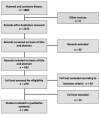MicroRNA as Epigenetic Modifiers in Endometrial Cancer: A Systematic Review
- PMID: 33800944
- PMCID: PMC7961497
- DOI: 10.3390/cancers13051137
MicroRNA as Epigenetic Modifiers in Endometrial Cancer: A Systematic Review
Abstract
The objective of this systematic review is to summarize our current knowledge on the influence of miRNAs in the epigenetic deregulation of tumor-related genes in endometrial cancer (EC). We conducted a literature search on the role of miRNAs in the epigenetic regulation of EC applying the Preferred Reporting Items for Systematic Reviews and Meta-Analyses (PRISMA) guidelines. The following terms were used: microRNA, miRNA, miR, endometrial cancer, endometrium, epigenetic, epimutation, hypermethylation, lynch, deacetylase, DICER, novel biomarker, histone, chromatin. The miRNAs were classified and are presented according to their function (tumor suppressor or onco-miRNA), their targets (when known), their expression levels in EC tissue vs the normal surrounding tissue, and the degree of DNA methylation in miRNA loci and CpG sites. Data were collected from 201 articles, including 190 original articles, published between November 1, 2008 and September 30, 2020 identifying 313 different miRNAs implicated in epigenetic regulation of EC. Overall, we identified a total of 148 miRNAs with decreased expression in EC, 140 miRNAs with increased expression in EC, and 22 miRNAs with discordant expression levels. The literature implicated different epigenetic phenomena including altered miRNA expression levels (miR-182, -230), changes in the methylation of miRNA loci (miR-34b, -129-2, -130a/b, -152, -200b, -625) and increased/decreased methylation of target genes (miR-30d,-191). This work provides an overview of all miRNAs reported to be involved in epigenetic regulation in EC including DNA methylation and RNA-associated silencing. These findings may contribute to novel strategies in diagnosis, risk assessment, and treatments aimed at miRNAs, their target genes or DNA methylation.
Keywords: Endometrial cancer; Epigenetics; Methylation; MicroRNA; miR-129-2; miR-130a/b; miR-182; miR-191; miR-200b; miR-230.
Conflict of interest statement
The authors declare no conflict of interest related to this work.
Figures


Similar articles
-
Epigenetic silencing of microRNA-34b/c and B-cell translocation gene 4 is associated with CpG island methylation in colorectal cancer.Cancer Res. 2008 Jun 1;68(11):4123-32. doi: 10.1158/0008-5472.CAN-08-0325. Cancer Res. 2008. PMID: 18519671
-
DNA methylation contributes to deregulation of 12 cancer-associated microRNAs and breast cancer progression.Gene. 2017 Mar 10;604:1-8. doi: 10.1016/j.gene.2016.12.018. Epub 2016 Dec 18. Gene. 2017. PMID: 27998789
-
CpG island hypermethylation-associated silencing of microRNAs promotes human endometrial cancer.Cancer Cell Int. 2013 May 16;13(1):44. doi: 10.1186/1475-2867-13-44. Cancer Cell Int. 2013. PMID: 23680357 Free PMC article.
-
Diagnostic value of microRNA panel in endometrial cancer: A systematic review.Oncotarget. 2020 May 26;11(21):2010-2023. doi: 10.18632/oncotarget.27601. eCollection 2020 May 26. Oncotarget. 2020. PMID: 32523655 Free PMC article. Review.
-
The Role and Function of microRNA in the Pathogenesis of Multiple Myeloma.Cancers (Basel). 2019 Nov 6;11(11):1738. doi: 10.3390/cancers11111738. Cancers (Basel). 2019. PMID: 31698726 Free PMC article. Review.
Cited by
-
Identification of Endometrial Cancer-Specific microRNA Biomarkers in Endometrial Fluid.Int J Mol Sci. 2023 May 12;24(10):8683. doi: 10.3390/ijms24108683. Int J Mol Sci. 2023. PMID: 37240034 Free PMC article.
-
MTFR2 promotes endometrial carcinoma cell proliferation and growth via the miR-132-3p/PI3K/Akt signaling pathway.Front Med (Lausanne). 2025 Mar 10;11:1505071. doi: 10.3389/fmed.2024.1505071. eCollection 2024. Front Med (Lausanne). 2025. PMID: 40129972 Free PMC article.
-
Emerging biologic and clinical implications of miR-182-5p in gynecologic cancers.Clin Transl Oncol. 2025 Jun;27(6):2367-2382. doi: 10.1007/s12094-024-03822-9. Epub 2024 Dec 11. Clin Transl Oncol. 2025. PMID: 39661239 Review.
-
Citation Contamination by Paper Mill Articles in Systematic Reviews of the Life Sciences.JAMA Netw Open. 2025 Jun 2;8(6):e2515160. doi: 10.1001/jamanetworkopen.2025.15160. JAMA Netw Open. 2025. PMID: 40504528 Free PMC article.
-
Immunohistochemical expression of Drosha is reduced in eutopic and ectopic endometrium of women with adenomyosis.Braz J Med Biol Res. 2022 Dec 12;55:e12375. doi: 10.1590/1414-431X2022e12375. eCollection 2022. Braz J Med Biol Res. 2022. PMID: 36515351 Free PMC article.
References
-
- Ferlay J., Laversanne M., Ervik M., Lam F., Colombet M., Mery L., Piñeros M., Znaor A., Soerjomataram I., Bray F. The Global Cancer Observatory—All Rights Reserved. [(accessed on 30 September 2020)];2020 Available online: https://gco.iarc.fr/
-
- Jasek K., Kubatka P., Samec M., Liskova A., Smejkal K., Vybohova D., Bugos O., Biskupska-Bodova K., Bielik T., Zubor P., et al. DNA Methylation Status in Cancer Disease: Modulations by Plant-Derived Natural Compounds and Dietary Interventions. Biomolecules. 2019;9:289. doi: 10.3390/biom9070289. - DOI - PMC - PubMed
-
- Carlos-Reyes Á., López-González J.S., Meneses-Flores M., Gallardo-Rincón D., Ruíz-García E., Marchat L.A., La Vega H.A.-D., De La Cruz O.N.H., López-Camarillo C. Dietary Compounds as Epigenetic Modulating Agents in Cancer. Front. Genet. 2019;10:79. doi: 10.3389/fgene.2019.00079. - DOI - PMC - PubMed
-
- Popovic R., Licht J.D. Emerging Epigenetic Targets and Therapies in Cancer Medicine. Cancer Discov. 2012;2:405–413. doi: 10.1158/2159-8290.CD-12-0076. - DOI - PMC - PubMed
Publication types
LinkOut - more resources
Full Text Sources
Other Literature Sources

